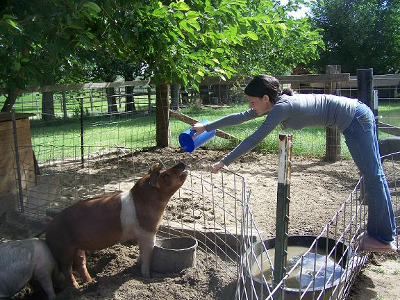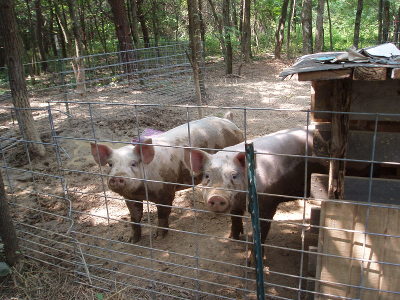
Feeder pigs and finishing hogs
 The first thing I learned from Storey's
Guide to Raising Pigs
was that my terminology was all wrong. I wrote previously about
my idea of raising two
pigs from when they're weaned (feeder pigs) until slaughter, which I now know is known
as finishing hogs. According to Klober, the term "pigs" is used
to refer to baby hogs, and piglet is "a layman's term for a young pig,
but don't use this around swine producers unless you want to be laughed
out of the coffee shop." After a short time, pigs grow into
shoats, than at 125 pounds they are known as hogs.
The first thing I learned from Storey's
Guide to Raising Pigs
was that my terminology was all wrong. I wrote previously about
my idea of raising two
pigs from when they're weaned (feeder pigs) until slaughter, which I now know is known
as finishing hogs. According to Klober, the term "pigs" is used
to refer to baby hogs, and piglet is "a layman's term for a young pig,
but don't use this around swine producers unless you want to be laughed
out of the coffee shop." After a short time, pigs grow into
shoats, than at 125 pounds they are known as hogs.
Except for getting the
wording wrong, though, my idea of starting our adventure by finishing
two hogs is a good one. The first step is to find someone who
will sell you pigs when they're around two months old and are well
weaned, at which time you should expect to pay anywhere from $50 to
$200 apiece for the pigs. I'll write more about selecting your
feeder pigs tomorrow, but it's worth noting that if you're skipping the
feeder-pig stage and going right into keeping your own breeding herd,
you'll need to pay more for top-quality genetics.
When you bring your
feeder pigs home, they'll weigh about 40 to 70 pounds, and they'll need
a little TLC at first. Until pigs are eight weeks old, it's best
to keep them on unlimited feed, to wire open the doors of self-feeders
and -waterers, and to keep littermates together.  Even after that, when you move pigs to a
new location, they may go off their feed for a few days and need some
electrolyte in their water (and, Klober suggests, some flavored gelatin
powder sprinkled on their food and in their water to increase
consumption). Walter Jeffries recommends keeping your new pigs in
a 16-by-16-foot area for a few days to get them used to you and to the
fencing before moving them to pasture.
Even after that, when you move pigs to a
new location, they may go off their feed for a few days and need some
electrolyte in their water (and, Klober suggests, some flavored gelatin
powder sprinkled on their food and in their water to increase
consumption). Walter Jeffries recommends keeping your new pigs in
a 16-by-16-foot area for a few days to get them used to you and to the
fencing before moving them to pasture.
Three to four months
after you bring them home, your pigs should have grown into hogs that
weigh more than you do. Hogs are usually butchered at 220 to 260
pounds, with the lower end of the weight range giving leaner meat and
the higher end providing more cost-efficiency at the butcher.
Expect to spend a bit longer growing out your hogs if you're raising
them on pasture, especially if the weather is cold.
Stay tuned for later
posts in this week's lunchtime series walking you through more of the
specifics of raising feeder pigs.
| This post is part of our Storey's Guide to Raising Pigs lunchtime
series.
Read all of the entries: |
Want more in-depth information? Browse through our books.
Or explore more posts by date or by subject.
About us: Anna Hess and Mark Hamilton spent over a decade living self-sufficiently in the mountains of Virginia before moving north to start over from scratch in the foothills of Ohio. They've experimented with permaculture, no-till gardening, trailersteading, home-based microbusinesses and much more, writing about their adventures in both blogs and books.
Want to be notified when new comments are posted on this page? Click on the RSS button after you add a comment to subscribe to the comment feed, or simply check the box beside "email replies to me" while writing your comment.
- Remove comment
